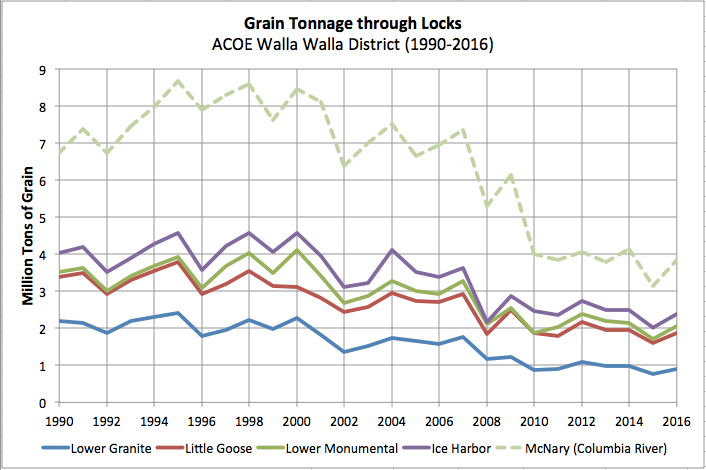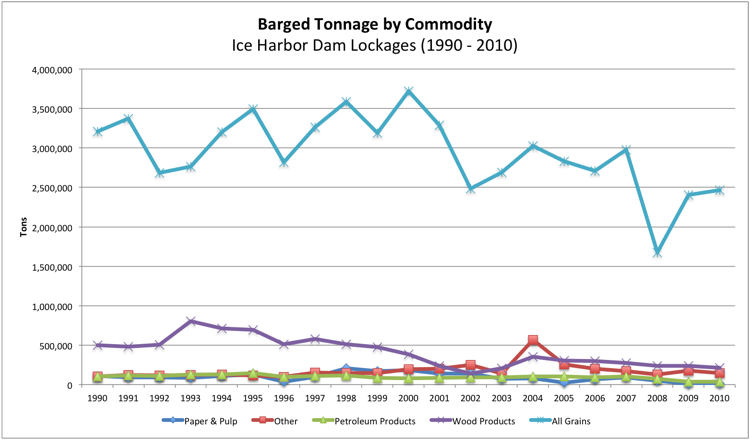forum
library
tutorial
contact

Why the Northwest is Debating
Dams on the Snake River (Again)
by Courtney Flatt
Oregon Public Broadcasting, November 21, 2016
|
the film forum library tutorial contact |

|
Why the Northwest is Debating
by Courtney Flatt
|
Julian Matthews is a member of the Nez Perce tribe.
He said the dams need to be removed as a matter of tribal treaty rights.

For more than half a century, dams on the Columbia and Snake Rivers have been taken for granted as a permanent part of the landscape. The four dams on the lower Snake River provide hydropower and navigation to the West Coast's most inland port -- in Lewiston, Idaho. They've also proven detrimental to threatened and endangered salmon and steelhead.
Now, a longstanding debate -- removing or altering the four lower Snake River dams -- is back at the forefront of a discussion on how to protect fish while still doing what's best for all interests along the Columbia and Snake rivers.
Why is this happening now?
This past May, Federal District Court Judge Michael Simon ordered dam operators to put all options back on the table to save threatened and endangered salmon and steelhead. "All options" means taking a hard look at the Snake River dams.
"Despite billions of dollars spent on these efforts, the listed species continue to be in a perilous state," Judge Simon wrote in his decision. "The [Federal Columbia River Power System] remains a system that ‘cries out' for a new approach."
The debate over protecting the fish has been tied up in the courts for more than 20 years. Simon's rejection his past May was the fifth time a federal judge has ruled against the government's plan that guides dam operations on the Columbia and Snake Rivers.
His order to look at all available options has led to a series of scoping meetings across the Northwest, where people can make public comments and voice their thoughts about how to best protect these fish. The most controversial option that's gotten the most attention: removing or altering the four lower Snake River dams.
What's happening at these meetings?
Many say ground zero for this debate is in Lewiston, Idaho, the most inland port on the West Coast, 465 river miles from the Pacific Ocean. The Snake River dams have helped build up the shipping town, but they've also been a catalyst for those seeking to protect more wild salmon runs.
The open house-style meeting Wednesday in Lewiston was the most well attended yet. More than 320 people made their way around a conference room, where officials and experts stood by poster boards explaining different parts about the dams, from their role in making the river navigable to commercial freight to the effects of climate change to hydroelectric power generation.
The dams were built in the 1960s and '70s. They generate about 5 percent of the region's energy annually, or enough for about 800,000 homes.
Demonstrators on both sides of the issue -- keeping or removing the dams -- attended rallies near the official meeting. Those in support of the dams carried signs with slogans like "Hydropower is clean energy." Others advocating for breaching the dams carried signs and wore orca costumes -- saying that the health of the southern resident killer whales is linked to the health of salmon runs.
Whether pro- or anti-dam, salmon were on people's minds.
What has happened to salmon runs since this dispute got started?
In recent years, Snake River salmon had seen record breaking and near-record breaking runs, thanks to efforts with hatchery fish, spilling more water over dams for juvenile fish and trucking salmon around dams.
But then a massive heat wave and drought hit in 2015, spiking river temperatures, which along with low river flows, proved lethal for fish. That year, 99 percent of the Snake River sockeye died before making it to their spawning grounds in Central Idaho's Sawtooth Basin.
That gave people a glimpse of what conditions might be like as the climate changes.
"When rivers are dammed the river flow slows down sometimes almost to nothing. And that means that it's warmer water temperatures, which correlates to increased fish mortality," said Chris Norden, with Friends of the Clearwater.
Norden said he's glad climate change is now a part of the discussion -- it had been left out of earlier conversations about the Snake River dams.
Jim Waddell is a former Army Corps of Engineer employee -- the agency owns and operates the four lower Snake River dams. Since his retirement, Waddell has become a strong advocate for breaching the dams.
"We are out of time with Snake River stocks," Waddell said. "These endangered stocks are on the verge of extinction."
There has also been another factor gaining attention in the debate: how the health of the Snake River salmon runs affect the health of southern resident killer whales. Salmon and whale advocates say removing or altering the four lower Snake River dams are a must for saving fish and orcas.
However, NOAA Fisheries says "no salmon recovery effort on a single river will bring about the recovery of southern resident killer whales on its own."
 What about people who want to keep the dams the way they are?
What about people who want to keep the dams the way they are?
A lot of people at the Lewiston meeting voiced their support of the dams, especially farmers who rely on the navigation provided by the dams to ship their products from the West Cost's most inland port.
Richard Grant grows wheat in Culdesac, Idaho, 20 miles outside of Lewiston.
"I just can't fathom taking the dams down," he said.
Grant said the dams are an important way for him to get his wheat to market. For his operation, rail and truck shipments could prove too costly and severely damage his bottom line.
Others said the dams made Lewiston what it is today, with the benefits of navigation to the regional economy and slackwater recreation they provide.
"We can have dams, and we can have fish, and we can have recreation. We can have all of that together, and I think we can all work together to really strengthen the system and build it," said Ken Blakeman, general manager of CHS Primeland, an agricultural cooperative in Lewiston.
What has been the tribal response?
Members of the Nez Perce tribe showed up to the meeting in Lewiston -- the tribe didn't sign onto the 2008 Fish Accords, which barred the tribes who did sign from litigating for additional fish protection at the dams or breaching of the Snake River dams for 10 years. In return, they received $900 million for salmon restoration projects in the Columbia Basin.
Julian Matthews is a member of the Nez Perce tribe. He said the dams need to be removed as a matter of tribal treaty rights.
"This is a treaty right we have to catch salmon. It doesn't say hatchery salmon. It doesn't say GMO salmon. It just says salmon, and that's what we are trying to fight to protect -- to get those native species. I want to catch those native species," Matthews said.
What happens next?
The meetings will continue in Boise (Nov 29), Seattle (Dec. 1), The Dalles, Oregon (Dec. 6), Portland (Dec. 7), and Astoria, Oregon (Dec. 8). The federal agencies will accept written comments through Jan. 17, 2017.
After that, the federal government will produce a first-draft proposal on what it thinks the next move should be.
Whether that includes options to remove or alter the Snake River dams, that decision will still be years away and would require and act of congress.
learn more on topics covered in the film
see the video
read the script
learn the songs
discussion forum
